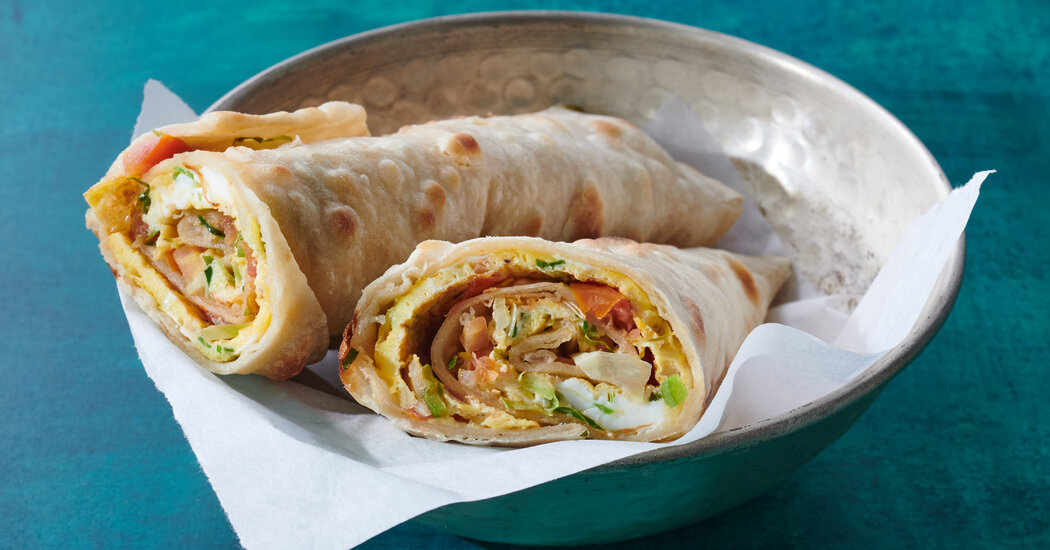
I once believed that weekend mornings were a time for elaborate culinary rituals.
After a quick jaunt to the farmers’ market for fruits and herbs, I would prepare biscuits or scones from scratch, while jazz or Afrobeat filled the air. Now, with a 4- and 1-year-old shaking me from sleep seven days a week, weekend breakfasts often begin the night before when I pull something from the small stand-alone freezer I keep in the laundry room.
It’s in that holy grail of an appliance that I store an assortment of doughs, vacuum-sealed meats, beans, sauces and breakfast staples I made or bought, like a whole shelf of chapati from Patel Brothers in Edison, N.J. Each month, with the kids napping in the car, I drive across the river from Brooklyn to stock up on dozens from the in-house bakery. If I take a few out of the freezer on Friday night, we’ll have rolled eggs on Saturday morning.
Say “rolled eggs” two or three times, and you’ll hear what you’ll be making: eggs, accented by ingredients you have on hand, rolled into a chapati. But say “rolled eggs” fast enough, and the -ed ending drops away, becoming “roll eggs.” Say it faster, a few more times, and you may hear “rolex,” both a luxury watch brand and the name of a popular Ugandan street food.
A rolex can be as elaborate or as superficial as you need it to be.
“There is freedom to experiment,” said Sophie Musoki, the Ugandan food writer and photographer who produces the podcast “Our Food Stories.”
“Fry the egg with onion, cabbage and, if you want, tomatoes,” she said. The tomatoes can be cooked or raw, “so there’s an element of freshness and acidity. A standard rolex doesn’t require much.”
Of course, its origins are far more complex. How a chapati, a South Asian staple, ended up in East Africa is a journey as complex as humanity’s own. As with many of the world’s best dishes, the intermingling of cultures has something to do with it. Chapati, samosas, kachumbari, chips mayai and certain spice blends — like what is often referred to as curry powder — are all examples of how the Indian diaspora has influenced the cuisine of Uganda, Kenya, Tanzania and other East African nations. Think of the rolex as another footnote in the story of colonialism, forced exile, adaptation and acceptance.
But further research into the rolex, beyond its history, heightened my curiosity about the chapati itself, the four-ingredient flatbread that anchors the rolled snack. In its original form, it’s unleavened and made from whole-wheat flour, but, as its reach stretched beyond India and across Southeast Asia, the Caribbean and East Africa, myriad versions emerged, playing on how it’s cooked and even the ingredients used.
In all my years as a restaurant and test kitchen cook, I’d never made one. I considered them the domain of other cooks. However, this past month, I made chapatis from scratch, with guidance from the recipe developer Kiano Moju. An owner of Jikoni Studios, Ms. Moju shared videos she took of her Maasai grandmother, Agnes Kiano Kasaine, kneading, then rolling and cooking off chapatis in the soft lighting of her kitchen on the outskirts of Nairobi, Kenya.
Ms. Moju explained that chapati recipes vary even across households: She and her grandmother use equal parts milk and water, a particularly Maasai preparation, given the abundance of dairy in the region, for a thin flaky chapati. The Kampala-based Ms. Musoki, on the other hand, relies on water and prefers a soft, chewy chapati, especially for the rolex.
My version, adapted from Ms. Moju and Ms. Kasaine’s recipe, turned out thin, flaky and full of delicately bound layers, fresh off the pan. In about an hour, I had replenished my freezer’s supply. With some diced tomato, onions, shredded cabbage, chile and, of course, eggs, I watched my rolex come together and felt a wave of nostalgia for weekends I once knew. Then, it was time to put them into the small hands of my two young daughters, and to witness their world of small delights.



